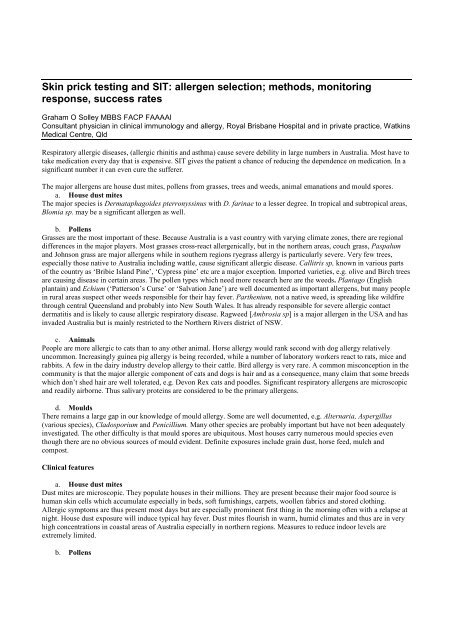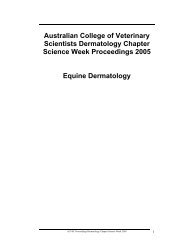Skin Prick Testing And SIT: Allergen Selection; Methods
Skin Prick Testing And SIT: Allergen Selection; Methods
Skin Prick Testing And SIT: Allergen Selection; Methods
You also want an ePaper? Increase the reach of your titles
YUMPU automatically turns print PDFs into web optimized ePapers that Google loves.
<strong>Skin</strong> prick testing and <strong>SIT</strong>: allergen selection; methods, monitoring<br />
response, success rates<br />
Graham O Solley MBBS FACP FAAAAI<br />
Consultant physician in clinical immunology and allergy, Royal Brisbane Hospital and in private practice, Watkins<br />
Medical Centre, Qld<br />
Respiratory allergic diseases, (allergic rhinitis and asthma) cause severe debility in large numbers in Australia. Most have to<br />
take medication every day that is expensive. <strong>SIT</strong> gives the patient a chance of reducing the dependence on medication. In a<br />
significant number it can even cure the sufferer.<br />
The major allergens are house dust mites, pollens from grasses, trees and weeds, animal emanations and mould spores.<br />
a. House dust mites<br />
The major species is Dermataphagoides pterronyssinus with D. farinae to a lesser degree. In tropical and subtropical areas,<br />
Blomia sp. may be a significant allergen as well.<br />
b. Pollens<br />
Grasses are the most important of these. Because Australia is a vast country with varying climate zones, there are regional<br />
differences in the major players. Most grasses cross-react allergenically, but in the northern areas, couch grass, Paspalum<br />
and Johnson grass are major allergens while in southern regions ryegrass allergy is particularly severe. Very few trees,<br />
especially those native to Australia including wattle, cause significant allergic disease. Callitris sp, known in various parts<br />
of the country as ‘Bribie Island Pine’, ‘Cypress pine’ etc are a major exception. Imported varieties, e.g. olive and Birch trees<br />
are causing disease in certain areas. The pollen types which need more research here are the weeds. Plantago (English<br />
plantain) and Echium (‘Patterson’s Curse’ or ‘Salvation Jane’) are well documented as important allergens, but many people<br />
in rural areas suspect other weeds responsible for their hay fever. Parthenium, not a native weed, is spreading like wildfire<br />
through central Queensland and probably into New South Wales. It has already responsible for severe allergic contact<br />
dermatitis and is likely to cause allergic respiratory disease. Ragweed [Ambrosia sp] is a major allergen in the USA and has<br />
invaded Australia but is mainly restricted to the Northern Rivers district of NSW.<br />
c. Animals<br />
People are more allergic to cats than to any other animal. Horse allergy would rank second with dog allergy relatively<br />
uncommon. Increasingly guinea pig allergy is being recorded, while a number of laboratory workers react to rats, mice and<br />
rabbits. A few in the dairy industry develop allergy to their cattle. Bird allergy is very rare. A common misconception in the<br />
community is that the major allergic component of cats and dogs is hair and as a consequence, many claim that some breeds<br />
which don’t shed hair are well tolerated, e.g. Devon Rex cats and poodles. Significant respiratory allergens are microscopic<br />
and readily airborne. Thus salivary proteins are considered to be the primary allergens.<br />
d. Moulds<br />
There remains a large gap in our knowledge of mould allergy. Some are well documented, e.g. Alternaria, Aspergillus<br />
(various species), Cladosporium and Penicillium. Many other species are probably important but have not been adequately<br />
investigated. The other difficulty is that mould spores are ubiquitous. Most houses carry numerous mould species even<br />
though there are no obvious sources of mould evident. Definite exposures include grain dust, horse feed, mulch and<br />
compost.<br />
Clinical features<br />
a. House dust mites<br />
Dust mites are microscopic. They populate houses in their millions. They are present because their major food source is<br />
human skin cells which accumulate especially in beds, soft furnishings, carpets, woollen fabrics and stored clothing.<br />
Allergic symptoms are thus present most days but are especially prominent first thing in the morning often with a relapse at<br />
night. House dust exposure will induce typical hay fever. Dust mites flourish in warm, humid climates and thus are in very<br />
high concentrations in coastal areas of Australia especially in northern regions. Measures to reduce indoor levels are<br />
extremely limited.<br />
b. Pollens
Airborne concentrations vary widely. Plants pollinate at different times of year. Trees generally pollinate in early spring,<br />
grasses throughout spring and summer and weeds in the hotter months as well as in autumn. Ragweed pollinates only in<br />
autumn. Symptoms occur outdoors but because many houses are built in hot/warm climates with open windows and doors<br />
symptoms can occur indoors as well, but often improve in an air-conditioned environment. They tend to improve also on<br />
wet days, during drought and at the coast [the prevailing winds across water carry very low pollen levels]. They increase on<br />
windy days and after periods of rain. Lawn mowing can, but not always cause significant symptoms.<br />
c. Animals<br />
Because salivary proteins are the major source of cat allergy for example, symptoms mainly occur indoors. Getting rid of<br />
the cat will not result in allaying the allergy problem because these particles will remain in carpets, soft furnishings, etc, for<br />
months and perhaps years. Furthermore many cat-allergic people have only to enter a house with an indoor cat and<br />
experience hay fever immediately on entry as the allergens are in the air.<br />
d. Moulds<br />
As indicated above, significant exposure to mould spores may be unknown. People involved in agricultural activities are<br />
those most prone to develop mould allergy.<br />
Medications such as antihistamines, nasal decongestants, bronchial dilators, and topical nasal or bronchial steroids provide<br />
adequate relief for the majority of people suffering from respiratory allergic disease. Many however have debilitating<br />
symptoms. For these <strong>SIT</strong> offers a chance to control and for some to eliminate the problem.<br />
Specific immunotherapy<br />
<strong>SIT</strong> is one of the longest standing medical therapies still in use, having been first employed in 1911. It of course has been<br />
modified, especially in the past two decades, to improve its efficacy and safety.<br />
a. Principles of treatment<br />
The specific allergens are administered to the patient, most commonly by subcutaneous injection and occasionally<br />
sublingually. Because the patient is challenged with a reagent he/she is allergic to, the treatment must be done in a very<br />
carefully controlled manner. The initial dose is so low that an allergic response is unlikely to develop. With tolerance of this<br />
challenge, subsequent doses rise gradually in a systematic manner. The aim of the exercise is to achieve tolerance of a dose<br />
higher than the level of allergen to which the person is naturally exposed. Suppression however following this induction<br />
series will only give brief relief. To gain long term control a maintenance regimen must follow. The patient then receives<br />
the top dose reached in the induction course for an indefinite period; e.g. 3 to 5 years.<br />
b. Reagents<br />
The most common include the house dust mite, D pterronyssinus, and grass pollens. In regard to the latter, the specific<br />
allergens vary in accordance with the region. Plantago <strong>SIT</strong> often is used. <strong>SIT</strong> is particularly effective in suppressing animal<br />
allergies, cat especially. [Indeed many veterinary science students have successfully had their cat, horse and dog allergies<br />
eliminated!]. Mould allergy remains the difficult one, but some patients do respond very well.<br />
c. Response to treatment<br />
Numerous studies, including double-blind, placebo-controlled, randomised, clinical trials demonstrate beneficial effect of<br />
<strong>SIT</strong> in allergic rhinitis, asthma and conjunctivitis, both in adults and children. My own review of 1210 patients with the<br />
above conditions in 2002 indicated that 21% achieved complete resolution of their illness, 54% were much better with only<br />
the occasional need for additional medication, 19% improved but required frequent medication. In only 6% <strong>SIT</strong> was<br />
ineffective.<br />
d. Immunologic observations<br />
Immunological changes during <strong>SIT</strong> are complex. [1] Successful <strong>SIT</strong> is associated with a change towards a Th1 CD4+<br />
cytokine profile. [2] <strong>SIT</strong> is associated with immunological tolerance defined as a relative decrease in allergenic-specific<br />
responsiveness and by the generation of CD4+CD25+ regulatory T lymphocytes. [3] Efficacy of <strong>SIT</strong> is not dependent on<br />
reduction of specific IgE antibody levels. In most patients with successful outcomes there is an initial rise in specific IgE<br />
levels which then decline as the treatment progresses. [4] <strong>Allergen</strong>-specific IgG antibodies generally increase but are not<br />
predictive of the duration and degree of efficacy of <strong>SIT</strong>.
e. Safety<br />
Large local swellings at injection sites are very common, ranging from 25 to 80% in patients in various studies. In most<br />
cases, these are of little consequence. Although there is a low risk of severe systemic reactions with appropriately<br />
administered <strong>SIT</strong>, life-threatening and fatal reactions have occurred. The most common reactions are urticaria with/without<br />
asthma. Systemic reactions develop in about 5% of recipients of <strong>SIT</strong>. In a retrospective analysis of the incidence and<br />
features of non-fatal systemic reactions in Italy during 1981 to 2000, there were 115 systemic reactions [5.2%] in 4000]<br />
patients in the first decade and 1.1% in the second. Systemic reactions may result from [1] incorrect dosage, [2] long<br />
intervals between injections, [3] the presence of respiratory infections or of asthma, [4] exercise soon after and occasionally<br />
before <strong>SIT</strong>, and [5] possible concomitant treatment with ß-adrenergic drugs. Typically if a systemic event occurs, the patient<br />
can continue the course usually free of further adverse systemic responses. Modification of the schedule is essential, e.g.<br />
reduction in dosage.<br />
Summary<br />
<strong>SIT</strong> gives the sufferer of significant allergic respiratory disease a real chance of a cure. It almost invariably provides<br />
adequate relief, it reduces dependence on medication and is usually well tolerated.<br />
Reference<br />
Cox L, Li JT, Nelson H, Lockey R Eds, <strong>Allergen</strong> immunotherapy: a practice parameter second update. J Allergy Clin Immunol.2007;120: S25-85.
















